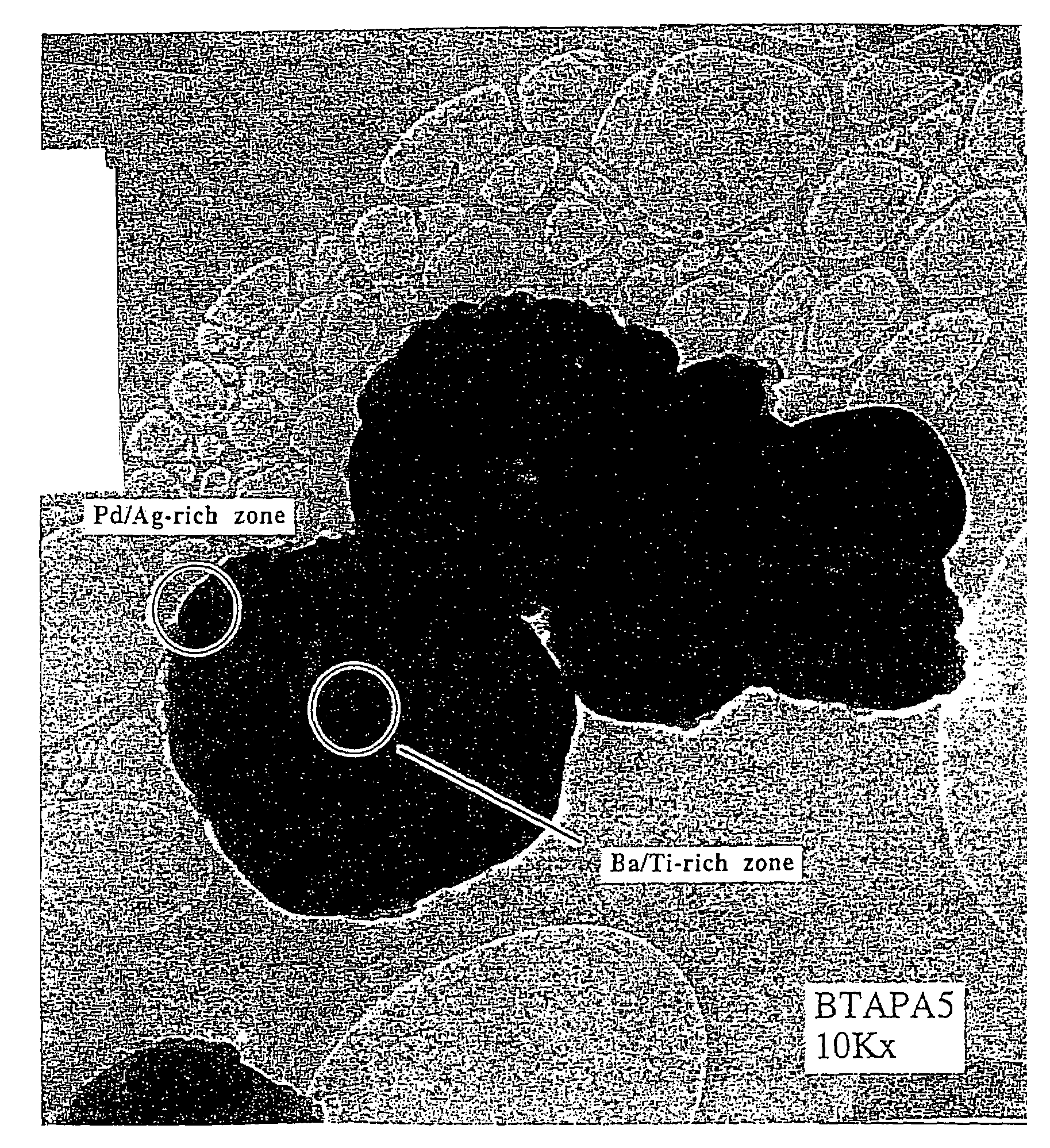Palladium-containing particles, method and apparatus of manufacture, palladium-containing devices made therefrom
a technology of palladium and pyrolysis system, which is applied in the field of aerosol methods, can solve the problems of difficult control of liquid precipitation technique to produce particles with desired characteristics, unsuitable commercial particle production, and ineffective spray pyrolysis system, etc., and achieves the effect of high quality
- Summary
- Abstract
- Description
- Claims
- Application Information
AI Technical Summary
Benefits of technology
Problems solved by technology
Method used
Image
Examples
example 1
[0315]This example demonstrates manufacture of single-phase palladium particles that include a small amount of calcium to improve resistance to oxidation of the palladium.
[0316]An aqueous solution including 5 weight percent palladium in the form of a dissolved nitrate and 0.26 weight percent calcium, relative to the palladium, in the form of a dissolved carbonate. In one case, an aerosol is generated using an ultrasonic generator including 6 ultrasonic transducers operating at 1.6 MHz. In another case, an aerosol is generated with an ultrasonic generator including an array of 49 ultrasonic transducers operating at 1.67 MHz. Both aerosols are then sent to a furnace at a temperature of 1100° C., where the palladium particles are produced by spray pyrolysis of the aerosol. Nitrogen gas is used as a carrier gas for the aerosol in both cases. Nitrogen is used as the quench gas in the case of the 6 transducer generator and air is used as the quench gas in the case of the 49 transducer gen...
example 2
[0318]This example demonstrates the preparation of palladium-containing powder in which the palladium is present in a 70 / 30 palladium / silver alloy.
[0319]An aqueous solution is prepared including dissolved palladium and silver as nitrates. The total amount of palladium and silver in the solution is 5 weight percent, with the relative proportions of palladium / silver being 70 / 30 on a weight basis, so that, if the silver and the palladium fully alloy, a 70 / 30 Pd / Ag alloy will be obtained in the particles. An aerosol is generated from a single transducer ultrasonic generator operating at a frequency of 1.6 MHz using a carrier gas of nitrogen. Generated aerosols are sent to a furnace to prepare the palladium-containing particles. Furnace temperatures are varied from 900° C. to 1400° C. The samples are cooled and collected.
[0320]Several particle samples are subjected to TGA testing in air to evaluate the weight gain of the particles as an indication of susceptibility to palladium oxidation...
example 3
[0323]This example demonstrates the detrimental effect on palladium oxidation resistance of using air as a carrier gas in the manufacture of particles with a palladium / silver alloy.
[0324]Palladium / silver alloy particles are made according to the procedure of Example 2, including a 70 / 30 Pd / Ag weight ratio in the liquid feed, except that air is used as the carrier gas instead of nitrogen. The particles are manufactured with a furnace temperature of 1000° C.
[0325]Based on TGA testing of the particles in air, assuming all weight gain is attributable to palladium oxidation, only about 26 percent of the palladium oxidizes, further demonstrating the beneficial effect of furnace temperature on oxidation resistance. Even though acceptable for many applications, this level of palladium oxidation is about twice as large as shown in Example 2 when nitrogen is used as the carrier gas.
PUM
| Property | Measurement | Unit |
|---|---|---|
| weight average size | aaaaa | aaaaa |
| temperature | aaaaa | aaaaa |
| crystallite size | aaaaa | aaaaa |
Abstract
Description
Claims
Application Information
 Login to View More
Login to View More - R&D
- Intellectual Property
- Life Sciences
- Materials
- Tech Scout
- Unparalleled Data Quality
- Higher Quality Content
- 60% Fewer Hallucinations
Browse by: Latest US Patents, China's latest patents, Technical Efficacy Thesaurus, Application Domain, Technology Topic, Popular Technical Reports.
© 2025 PatSnap. All rights reserved.Legal|Privacy policy|Modern Slavery Act Transparency Statement|Sitemap|About US| Contact US: help@patsnap.com



